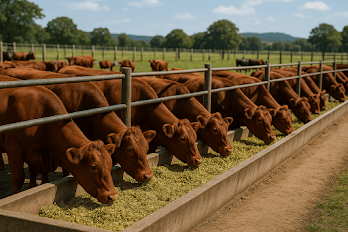Beef Cattle Farming
is a type of animal farming that is a Profitable and sustainable agricultural venture and supplies high-demand
red meat across the world. Whether
you're a small-scale farmer or aspiring to start a commercial feedlot, this
guide will walk you through everything from Breed Selection to Feeding, Housing, Marketing, and Profitability.
Table of Contents
- Introduction
- Popular Beef Cattle Breeds
- Cattle Housing and Management
- Feeding and Nutrition
- Health Care and Vaccination
- Breeding Management
- Marketing and Selling Beef Cattle
- Profitability and Challenges
- Conclusion
- FAQs
Introduction
Beef Cattle Farming
focuses on raising cattle for meat production, unlike Dairy Farming, which
emphasizes milk. Cattle rearing presents
an excellent opportunity to generate income due to the growing global demand
for high-quality Beef. Farmers can have a Sustainable and business
with the right planning,Breed Selection, and care.
Popular Beef Cattle Breeds
Choosing the right
breed depends on climate, growth rate, feed conversion, and market
preference. Here are some top beef
cattle breeds:
| Breed | Origin | Characteristics |
|---|---|---|
| Angus | Scotland | High marbling, polled (no horns), excellent meat quality |
| Hereford | England | Docile, hardy, red body with white face |
| Charolais | France | Heavy muscled, cream/white coat, fast growth rate |
| Brahman | India/USA | Heat-tolerant, disease-resistant, loose skin, hump on shoulder |
| Simmental | Switzerland | Dual-purpose, rapid weight gain, adaptable to climates |
| Limousin | France | Lean meat, high feed efficiency, golden-red coat |
| Shorthorn | England | Red, white or roan color, good for crossbreeding, calm nature |
| Gelbvieh | Germany | Fertile, good milk production, reddish-gold, early maturity |
Tip: Crossbreeding (e.g., Angus × Brahman) is also used to combine strengths
like marbling and heat resistance.
Cattle Housing and Management
Comfort, health, and
productivity are all guaranteed by decent housing. Requirements for an ideal housing are as under:
• Ventilation: Good air flow reduces
stress and disease.
• Space: At least 20–30 sq.m per adult
cow in open paddocks.
• Drainage: Prevent muddy or
water-logged areas.
• Fencing: Secure perimeter to avoid
escapes.
• Shade or shelter: Keep out the rain and sun.
Housing Techniques:
• Open grazing: Cattle roam freely (extensive).
• The intensive feedlot system, which includes daily feed supply and confined enclosures,
Feeding and Nutrition
Feeding beef cattle
correctly leads to faster weight gain and better meat quality.
Feeds of all kinds:
1. Roughages: Silage, grass, and hay are roughages.
2. Concentrates: Grains like corn, wheat bran, soybean meal.
3. Minerals and Vitamins: Salt licks,
premixes.
Phases of Feeding:
• Calves: Milk + calf starter.
• Weaners: protein concentrate and forage.
• Fattening Stage: High-energy diet for weight gain (feedlot)
Water: Clean water must be available at all times.
Health Care and Vaccination
Healthy cattle =
productive cattle. Establish a strict
health care protocol.
Common Diseases:
| Disease | Symptoms | Prevention |
|---|---|---|
| Foot and Mouth | Drooling, lameness | Regular vaccination |
| Bloat | Swollen belly, discomfort | Balanced feeding and roughage |
| Blackleg | Sudden death | Annual vaccination |
| External Parasites | Scratching, hair loss | Spray or pour-on insecticides |
Routine Practices:
• Hoof trimming
(if confined)
• Fly control.
Breeding Management
Proper breeding
ensures genetic improvement and regular stock turnover.
Natural Breeding vs AI:
• Natural: A bull mates with cows (good
for rural farms).
• Artificial Insemination (AI):
Preferred in commercial farms for breed selection.
Heat Detection:
• Mounting behavior
• Clear vaginal discharge
• Increased activity
Ideal breeding age: 15–18 months, with calving interval of 12–14 months.
Marketing and Selling Beef Cattle
Options:
• Live cattle: Sold to butchers or
abattoirs.
• Contract buyers: Feedlots, beef
companies, supermarkets.
• Directly to the consumer: farmer's markets, sales of organic beef.
• Sell at ideal weight (approx. 400–600
kg for steers).
• Target festive seasons or market
shortages for higher prices.
• Brand your beef as organic or
grass-fed for premium markets.
Profitability and Challenges
Potential Earnings:
• Profit per animal (after expenses): $500+
• ROI improves with scale, feed
efficiency, and smart marketing.
Challenges:
• High feed prices
• Disease outbreaks
• Water scarcity in dry areas
• Market price fluctuations
Solution: Maintain proper records, plan for dry seasons, insure your herd if
possible.
Conclusion
Beef Cattle Farming
is a rewarding business for those who are committed and knowledgeable. By selecting the right Breed, following
proper Feeding and Housing practices, and staying updated with animal health
protocols, you can build a Profitable Cattle enterprise.
Whether you’re Farming 5 cows or running a 500-head feedlot, success comes from consistent
care, good planning, and strong Marketing.
❓FAQs
1.What are the best Breeds for beef cattle?
Top Breeds like Angus, Hereford, Brahman, and Charolais are known for their quick growth and high-quality meat.
2.How much land is needed to raise beef Cattle?
For grazing, plan at
least 1–2 acres per cow. In feedlots,
less space is needed but feed cost is higher.
3.How long does it take to raise Beef Cattle for slaughter?
Typically 18–24
months depending on Breed and Feeding method.
4.Can Beef Cattle Farming be done with low investment?
Yes, open grazing and
local breeds can cut costs, but they may also result in lower returns.




















0 Comments